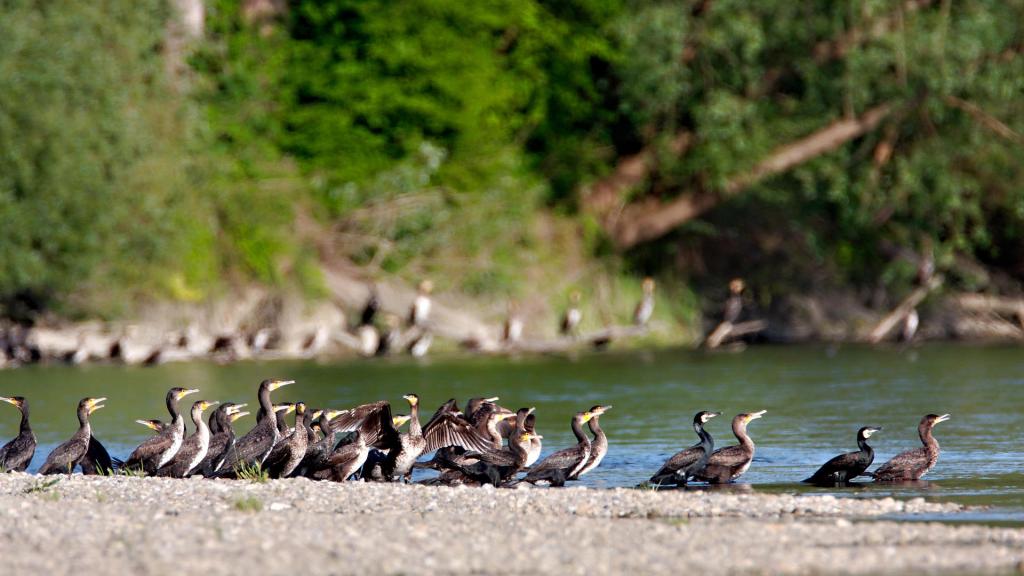Croatia

With a national territory of 87,609 km2, Croatia is at the intersection of the Pannonian Plain, the Balkans and the Adriatic. The country straddles the border of two major catchment areas: the Danube Basin and the Adriatic Sea. Draining over 62% of Croatia’s mainland, the Danube Basin covers the northern and central inland section of the country and is home to 69% of the population. Croatian territory accounts for 4.4% of the entire Danube Basin.
The Croatian section is dominated by major rivers (and their tributaries), notably the Drava, Sava and the Danube itself. Croatia has been a signatory to the Danube River Protection Convention since 1994.
Croatia’s Landscape, Climate and Water Flow
The Danube River Basin landscape is diverse in Croatia: the low Pannonian Plain dominates the north while upland karst areas cover the south (central Croatia). The upland area (averaging at 1,000 m a.s.l) comprises Dinaric karst, through which the watershed between the Danube and Adriatic Basins pass through. The Dinaric Mountains include Croatia’s highest peak, Mount Dinara, at 1,831 m a.s.l.
The Danube region is dominated by the wide elongated alluvial valleys of the Sava and Drava Rivers, which gradually narrow towards the west and are filled with large quantities of swamp and alluvial sediments. Climate and precipitation regimes are diverse: a continental climate exists in the north and east and a Mediterranean climate along the coast. The Danube region is dominated by the continental regime, but Mediterranean influences are strongly felt on the fringes along the watershed: a transitional zone encompasses almost all of the Kupa Basin. Nationally, average annual precipitation varies between 650 mm in eastern Slavonia (in the NE) to 3,500 mm plus in Gorski kotar (NW Croatia) and average annual temperatures range from 3 to 17 °C. Hydrologically, the Danube Basin can be divided into three units in Croatia: the basins of the Drava and the main Danube river occur to the north in the Pannonian Basin; while in the south, partly straddling the Dinaric karst, is the Sava Basin. Sava tributaries include the Kupa, Bosut and Una, while the Bednja flows into the Drava.
Natural highlights
- Plitvice Lakes National Park and UNESCO World Heritage Site - Croatia’s oldest and largest national park is famous for its outstanding natural beauty: stunning waterfalls, brightly coloured lakes and undisturbed karstic deposits;
- Risnjak National Park – located in the Dinaric Alps, a highly diverse flora exists due to the mixture of Dinaric, Alpine, coastal and continental influences;
- Lonjsko polje Nature Park and Ramsar site - the largest protected wetland in the whole Danube Basin and an Important Birds Area (IBA) under the EU Birds Directive;
- Kopački rit Nature Park and Ramsar site – comprising of a large area of relatively undisturbed floodplains around the confluence of the Drava and Danube rivers, it is one of the largest natural wetlands in Europe;
- Mokro polje and Crna Mlaka RAMSAR sites.
Manmade Impacts
Croatia contains large quantities of both surface and ground water resources, although they are unevenly distributed. While arable areas dominate low-lying parts of the Danube Basin, the upland regions of north and central Croatia are forested. The Basin is particularly unevenly populated. The majority of the population lives in the larger towns (density is greatest in Zagreb and Osijek) while other areas, particularly mountainous ones, are very sparsely populated.
A major portion of electrically generated energy comes from hydropower, with the Drava currently providing the largest input. The most effective locations are being exploited. However, new sites could potentially cause significant environmental impacts. The Drava and the Danube are major routes for international transportation (80% of goods shipped on inland waterways involve international trade) and the four-country Framework Agreement on the Sava Basin aims to further develop navigation. Discharging wastewater (both treated and untreated) into watercourses is common practice, but discharge directly into groundwater is prohibited. The majority of industrial facilities discharge into public sewerage systems; some of which is then treated before release into watercourses. Concerning drinking water, 90% of abstractions are from groundwater, with the remainder stemming from rivers and reservoirs; surface water intakes are few in number. An important measure for protecting drinking water aquifers is the adoption and enforcement of sanitary protection zones, a challenging task at most abstraction sites.
Estimates indicate 15% of the mainland is at risk of flooding; however the major part is protected to varying degrees. For example, in the Sava Basin, the middle basin plays a key role in protecting the Slavonian stretch and neighbouring countries due to the reduction in peak flows of flood waves in lowland flood storages. Measures, based on lowland flood storages and expansion areas, have enabled preservation of environmentally favourable conditions on wide floodplains. In the Drava and Danube Basins, protection is based on embankments and wide foreshores.
Pollution
Regarding organic load, of the 28% of wastewater that is treated, 43% undergoes preliminary/primary treatment and 57% secondary treatment. The most serious isues occur in small settlements (up to 2,000 inhabitants), where 40% of the population resides. The situation in settlements with more than 10,000 inhabitants is considered satisfactory in the main. 44% of all settlements with built-in sewerage systems have a wastewater treatment plant. Out of 109 plants, 38 involve preliminary treatment, 24 primary, 46 secondary and one tertiary. Modified economic conditions have meant that many industries have constructed their own plants for preliminary treatment. At the same time, connection rates for public sewerage systems with central municipal plants have not taken place at the rate predicted. Major parts of many settlements remain without connection to central treatment plants.
Based on processed data, agriculture pollution shows the highest loads from diffuse sources present in the Drava and Danube Basins and in the immediate Sava Basin. Only a small number are currently mentioned as priority and dangerous substances.
For more detailed information and statistics on the above, please download the 'Facts & Figures' fact sheet below.





